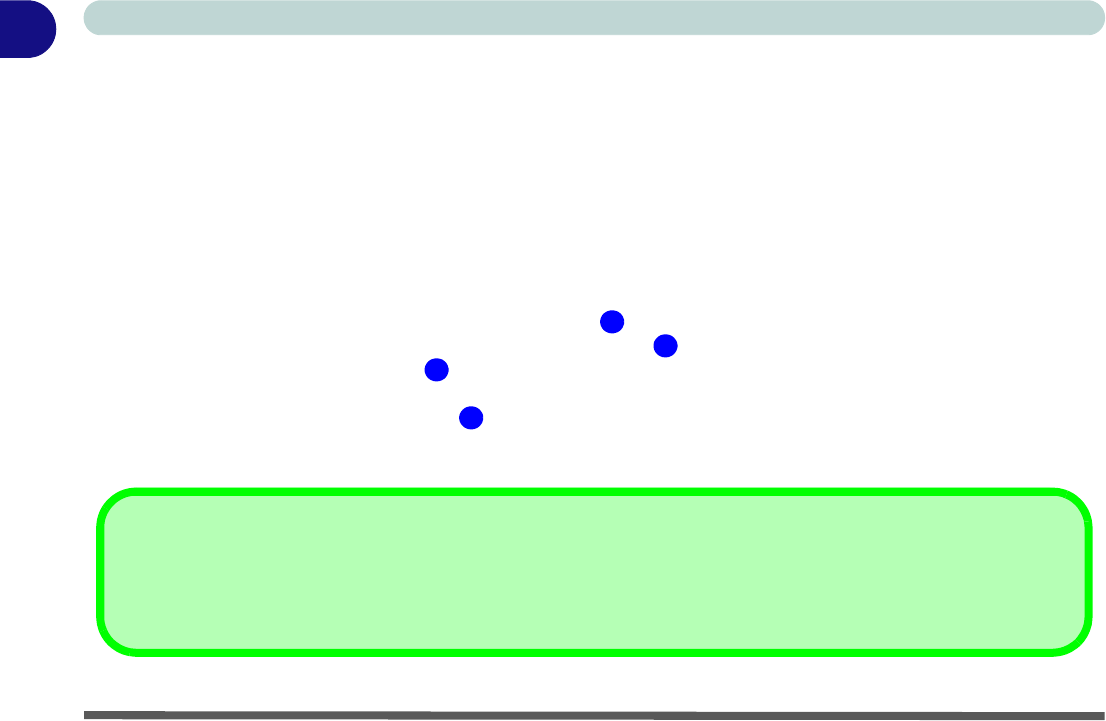User Manual
Table Of Contents
- Manual
- Preface
- Chapter 1: Quick Start Guide
- Chapter 2: Storage Devices, Mouse, Audio & Printer
- Chapter 3: Power Management
- Chapter 4: Drivers & Utilities
- What to Install
- Driver Installation
- Manual Driver Installation
- Updating/Reinstalling Individual Drivers
- User Account Control (Win Vista)
- Windows Security Message
- New Hardware Found
- Driver Installation Procedure
- Chipset
- Video
- Audio
- Modem
- LAN
- TouchPad
- Card Reader/ExpressCard
- Hot Key
- Intel MEI Driver
- e-SATA Support
- Optional Drivers
- Wireless LAN
- PC Camera
- 3.5G Module
- Fingerprint Reader Module
- Intel Turbo Memory Technology Driver
- Chapter 5: BIOS Utilities
- Overview
- The Power-On Self Test (POST)
- The Setup Utility
- Main Menu
- Advanced Menu
- Installed O/S (Advanced Menu)
- SATA Mode Selection (Advanced Menu)
- DFOROM (Robson) Support (Advanced Menu > SATA Mode Selection [AHCI]
- Boot-time Diagnostic Screen: (Advanced Menu)
- Legacy OS Boot: (Advanced Menu)
- Reset Configuration Data: (Advanced Menu)
- Power On Boot Beep (Advanced Menu)
- Battery Low Alarm Beep: (Advanced Menu)
- Fan Control (Advanced Menu)
- Security Menu
- Boot Menu
- Exit Menu
- Chapter 6: Upgrading The Computer
- Chapter 7: Modules
- Chapter 8: Troubleshooting
- Appendix A: Interface (Ports & Jacks)
- Appendix B: NVIDIA Video Driver Controls
- Appendix C: Specifications
- Appendix D: Windows XP Information
- DVD Regional Codes
- Windows XP Start Menu & Control Panel
- Audio Features
- Function/Hot Key Indicators
- Video Features
- NVIDIA Video Driver Controls
- Power Management Features
- Configuring the Power Button
- Battery Information
- Driver Installation
- Bluetooth Module
- Wireless LAN Module
- PC Camera Module
- 3.5G Module
- Fingerprint Reader Module

1 - 16 Video Features
Quick Start Guide
1
Video Features
You can configure display options, from the Display Settings control panel in Windows as long as the appro-
priate video driver is installed. For more detailed video information see “NVIDIA Video Driver Controls” on
page B - 1.
To access Display Settings in Windows:
1. Click Start, and click Control Panel (or point to Settings and click Control Panel).
2. Click Adjust screen resolution under the Appearance and Personalization menu (or double-click
Personalization > Display Settings).
3. Move the slider to the prefer red setting in Resolution: (Figure 1 - 9 on pag e 1 - 17 ).
4. Click the arrow, and scroll to the preferred setting In Colors: (Figure 1 - 9 on page 1 - 17).
5. Click Advanced Settings (button) (Figure 1 - 9 on page 1 - 17).
6. Click GeForce..... (tab).
7. Click Start the NVIDIA Control Panel (Figure 1 - 9 on page 1 - 17) to access the control panel.
8. The NVIDIA Control Panel can also be accessed by right-clicking the desktop, and then clicking NVIDIA
Control Panel (or from the NVIDIA Control Panel in the Windows control panel).
1
2
3
4
Video Card Options
Note that card types, specifications and drivers are subject to continual updates and changes. Check with your service center for the latest
details on video cards supported.










